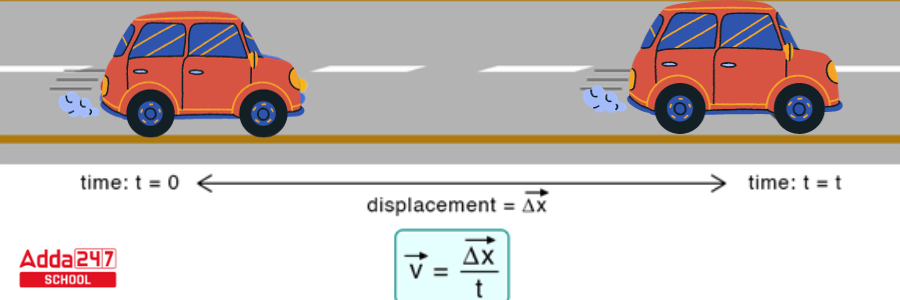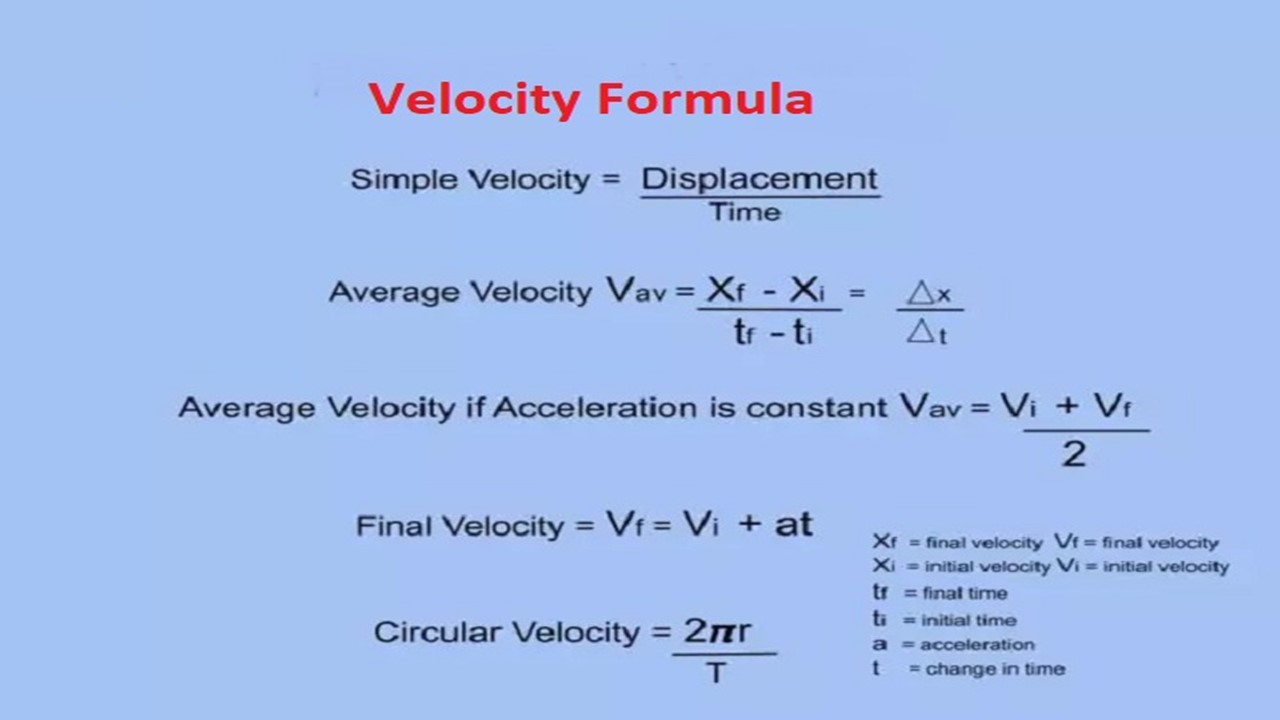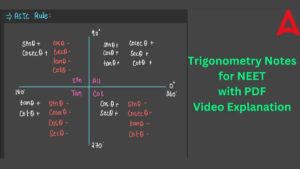Velocity
Velocity is a vector measure of the level and direction of movement. In simple words, velocity is the speed at which an object moves in one direction. Velocity brings something to the debate. Velocity, which physicists refer to as a “vector quantity,” includes both magnitude and direction. In contrast, speed is a “scalar quantity,” a phenomenon that deals with size but not direction.
Velocity Definition
Velocity is defined as the rate of change of an object’s position with respect to time. It tells you how much an object’s position changes in a specific time interval and in which direction.
Velocity Formula
Mathematically, velocity is represented as the derivative of an object’s position function with respect to time. In one dimension (for linear motion): Velocity Formula=Change in Position/Change in Time

Velocity Units
The standard SI unit for velocity is meters per second (m/s). Other common units include kilometers per hour (km/h), feet per second (ft/s), and miles per hour (mph), depending on the context. Students should always consider the units of velocity while solving any question based on this topic.
Speed vs. Velocity
While speed refers to the magnitude of an object’s velocity (how fast it’s moving), velocity includes information about both the speed and direction of motion. In other words, velocity specifies not only how fast something is moving, but also in which direction it’s moving.
| Difference between speed and Velocity | |
| SPEED | VELOCITY |
| It is the rate at which an object travels a specific distance. | The pace at which an object changes position in a specific direction is referred to as velocity. |
| Speed is fundamentally a scalar quantity. | Velocity is primarily a vector quantity. |
| The speed of an object reveals how quickly it moves. | It indicates the object’s speed as well as its position. |
| It is the pace at which distance changes. | It is the rate of displacement change. |
| Speed and velocity can be equal or not. | An object’s velocity may vary, but its speed remains constant. |
| A moving object’s speed can never be negative. | A moving object’s velocity can be zero. |
| The object’s speed is a good measure of its speed. | The primary indicator of an object’s position and speed is its velocity. |
| It is defined as the distance travelled by an object in one unit of time. | The displacement of an item in unit time is defined as velocity. |
Positive and Negative Velocity
A positive velocity indicates motion in one direction, while a negative velocity indicates motion in the opposite direction. The sign of the velocity is determined by the direction chosen as positive.
Average and Instantaneous Velocity
Average velocity is the total displacement divided by the total time taken. Instantaneous velocity, on the other hand, is the velocity of an object at a specific instant in time.
Constant Velocity
Constant velocity occurs when an object moves in a straight path at a constant speed. This means that the velocity of the object does not change over time and does not accelerate or decelerate. Constant velocity is a fundamental notion in physics and engineering that is used to describe the motion of objects across a wide range of conditions. Constant velocity is also known as uniform motion since the object moves at a constant rate without changing its speed or direction.
An object must have a net force operating on it that is equal and opposite to the forces of friction or drag that would otherwise slow it down or change its direction of motion in order to maintain a constant velocity. This enables the object to keep its speed and direction of motion constant while moving at a constant pace.
Uniform and Non Uniform Velocity
If an object’s velocity remains constant over time, it’s moving with uniform velocity. If the velocity changes over time, it’s moving with non-uniform velocity. The object with the uniform velocity has 0 acceleration value.
Velocity Vector Nature
Since velocity includes both magnitude and direction, it’s a vector quantity. This means that to fully describe an object’s velocity, you need to specify both its speed and the direction it’s moving in. We cannot describe the velocity properly without defining its direction.
Velocity Time Graph
A graph that shows how an object’s velocity changes over time is called a velocity-time graph. The slope of this graph represents the object’s acceleration. Different conditions of velocity-time graph represents different types of acceleration.
Relative Velocity
When dealing with multiple objects in motion, the relative velocity between them is the velocity of one object as observed from the perspective of the other object.
Velocity is a crucial concept in understanding the motion of objects and is foundational in various fields, including physics, engineering, and astronomy.
Velocity Formula Physics
Everyone is aware of Velocity Formula, however, there is a misunderstanding regarding it. The common misunderstanding is that speed and velocity are synonymous, although this is not the case. Furthermore, most individuals confuse the two and use them interchangeably. Furthermore, they are similar but not identical. In this article, we have covered every minimal detail about velocity and also we have covered the formula of velocity.
If physics confuses you and you are searching for the definition of velocity and Velocity Formula then this is the right article for you. Bookmark this page to get related topics, we have covered the Velocity Formula in a laymen’s language for a better understanding of students who are stuck in physics and find physics complicated.
Formula of Velocity in Physics for Exams
Velocity Formula- Velocity is the rate of change in displacement with respect to time i.e. it is a measurement of how long it takes an object to travel in a straight line to its destination. Velocity is a two-dimensional vector quantity with magnitude and direction, which means velocity has magnitude and direction. The unit of velocity is meter per second(m\s) and it is represented by V. If students are still confused about what velocity is then we have simplified it more, check the definition given below we have compared the distance with displacement to clear the confusion of student.
It relates to the rate at which displacement changes over time. Furthermore, the velocity is defined by distance and displacement. There will also be no velocity if there is no displacement in the object’s potion and the object does not travel any distance. So, what exactly is the distinction between displacement and distance? The net change in the position of a moving object is referred to as displacement. Distance, on the other hand, refers to the amount of ground covered by a moving item.
Sure, here are some common velocity formulas:
Average Velocity: This is the change in position divided by the change in time. Formula: Average Velocity=Change in Position/Change in Time
Instantaneous Velocity: This is the velocity at a specific instant in time. For continuous motion, it’s the derivative of the position function with respect to time.
Uniform Velocity: This is when an object travels with a constant velocity, which means the rate of change of its position with respect to time is constant. Formula: Uniform Velocity=Change in Position/Change in Time
Final Velocity: This is the velocity of an object at a specific moment in time. Formula: Final Velocity=Initial Velocity+(Acceleration × Time)
Velocity with Constant Acceleration: When an object is under constant acceleration, this formula calculates its velocity at a given time. Formula: Velocity=Initial Velocity+(Acceleration × Time)
Escape Velocity: The minimum velocity required for an object to break free from a gravitational field. Formula: Escape Velocity=2×Gravitational Constant × Mass of Planet-Distance from Center of Planet
Circular Motion Velocity: For an object moving in a circle, this formula calculates its linear velocity. Formula: Velocity=Radius × Angular Velocity
Tangential Velocity: The linear velocity of an object moving along the edge of a circular path. Formula: Tangential Velocity=Radius × Angular Velocity
Relativistic Velocity Addition: When velocities approach the speed of light, the addition of velocities must take into account relativistic effects. Formula: , where ′ is the relative velocity, and are the individual velocities, and is the speed of light.
These are just a few of the many velocity-related formulas that are used in various scientific and engineering contexts. Remember to always use the appropriate units and constants when applying these formulas.
Velocity Formula Physics for Board Exams
Let’s have a look at the velocity formula. As previously stated, velocity is defined as a change in an object’s displacement over time. Simply said, velocity is a measurement of how long it takes an object to go in a specific direction. Furthermore, it is proportional to the displacement and inversely proportional to travel time. Its unit is also the meter per second (m/s). The formula of velocity is given below:
V = s/t
Where,
V = Velocity
s = Displacement
t= Time
Read: Permanent Tissues
Velocity Formula in Terms of Displacement
Velocity Formula = (xf – xi)/t = Δx/t
Where,
v = Velocity (m/s)
xf = The final position (m)
xi = The initial position (m)
t = The time required
Δx = “The change in” position (m)
Angular Velocity Formula
The Angular Velocity Formula (for rotational motion) is given below
ω = θ/t
Where is the angular speed in radians unit time, θ is the angle in radians.
Average Velocity Formula
The Average Velocity Formula takes into account the total distance travelled in total time. The formula for the same in vector form is given herein.
where,
v is equal to the average velocity, Δx is displacement, and Δt is the change in time.
Velocity Equation
The general velocity equation is given by,
Velocity = Distance/ Time
Escape Velocity Formula
The escape velocity formula is the velocity required by an object to leave the gravitational field of the earth. The formula for the escape velocity is:
M = Mass of the body/object to be escaped from.
ve = escape velocity.
r = the distance from the center of the mass.
Final Velocity Formula
The final velocity is the velocity obtained by the object after a certain time period. The Final Velocity Formula is:
v = u + at
Where, u = initial velocity
v = final velocity
a = acceleration
t = time
Initial Velocity Formula
The velocity of the object from when the object is taken into consideration is said to be the Initial Velocity and its formula is given by:
u = v – at
Where , u = initial velocity
v = final velocity
a = acceleration
t = time
Linear Velocity Formula
The velocity along a straight path is known as the linear velocity. The formula for the same is given below.
Velocity (v) = s/t
We know that s = r θ,v = r θ/t
Now we replace θ/t by ω.
Read: Photosynthesis
All Velocity Formulas
All the different velocity formulas to calculate different velocities are as follows:
- v = s / t
- v = (xf – xi)/ t = Δx / t
- v = u + at
- ω = θ / t
- ve = √2Gm/ r
Velocity Formula Examples-Based Practice Questions
Velocity Formula practice questions for Students mug up the concepts but forget to apply them. To ease of students we have provided some questions of this topic. Students are advised to practice all the questions given on this page. It will boost their confidence and help them in their exams and also with practice questions students can fetch more marks in the examination. Hence, to score good marks on physics papers students must practice questions as much as they can instead of mugging concepts. Check the questions based on the Velocity formula given below and try to solve them.
Q. A boy traveling through a car and he covers a distance of 100 km in 2 hours what is the velocity?
Solution:
V = s/t
V = Velocity =?
s = Displacement = 100km
t= Time = 2 hours
As we have discussed earlier the unit of velocity is meters per second and here the units are given in kilometer and hour. so, first, we change the units in meters and seconds then we will apply the formula of velocity. Many students often made this mistake they don’t check the units and they direct apply the formula which is totally wrong and they end up losing marks in the examination.
V = 100*1000/2*60*60 m/s
V(velocity) = 13.88 m/s
13.88 m/s is the velocity of the boy to reach the destination.
Q. Let’s look at another situation in which we have the velocity and time values and must calculate displacement. The velocity and time values are 2 m/s and 50 seconds respectively. Determine the displacement value.
Solution: In the question, we have given velocity and time, we have to calculate the displacement. Here we have given the exact units so we need not convert the units in meters and seconds.
Velocity = 2m/s
Time= 50 seconds
Displacement=?
V = s/t
To calculate displacement we have to alter the formula
S = v*t
S = 2*50 meter-second
S= 100 ms
So we get displacement here 100 ms, meter-second is the unit of displacement. We don’t need to convert the unit in this question because we have given the desired units.
Related Post:















 Physics Investigatory Project Class 12 T...
Physics Investigatory Project Class 12 T...
 CBSE Class 12 Physics Viva Questions wit...
CBSE Class 12 Physics Viva Questions wit...
 Trigonometry Notes for NEET, Download PD...
Trigonometry Notes for NEET, Download PD...














